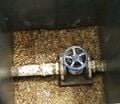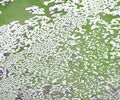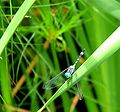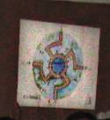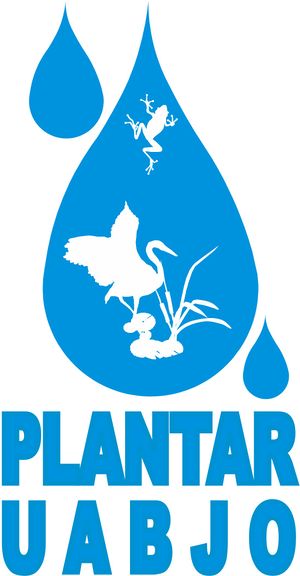
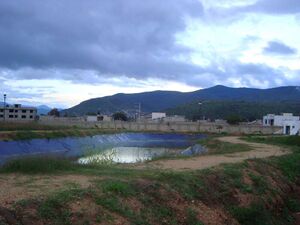
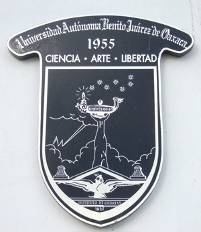
Introduction
In 2006, the University of Benito Juarez in Oaxaca, Mexico (UABJO) implemented a natural wastewater treatment, reuse, demonstration and outreach program. This program continues to grow and has yielded many measurable successes, as depicted by following three elements:
1. Applied Bachelor's and Master's Chemistry Academic Programs. These water quality focused, service-learning programs are providing surrounding commuinties assesments of potable water and treated wastewater quality. In addition, coursework evaluates levels of contamination in the major waterways of the Oaxaca Valley, such as the Rio Salado and Rio Atoyac. Although water quality analyses are conducted in the University laboratory by students, and are not nationally certified, this data is helping to fill in largely non-existant environmenal water quality inforation within the region.
2. An on-campus demonstration wetland wastewater treatment system that treats a portion of campus wastewater and reuses this treated wastewater for on-campus landscaping. This systems also serves as a living laboratory for UABJO Chemistry Department students.
3. An outreach program that consists of an ongoing conference series; demonstration system workshops; local community outreach; wastewater quality monitoring and analysis; and international exchange opportunities
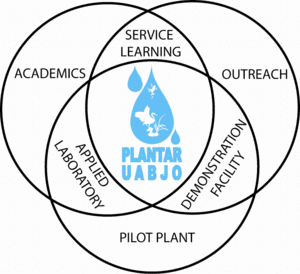
Background
Oaxaca City, the Oaxaca State capital comprised of approximately 265,000 in habitants, is about 5000 feet above sea level in the Sierra Madre de Sur Mountains. The rainy season in Oaxaca is normally June to August. Oaxaca City recently installed an activated sludge wastewater treatment plant, prior to which no wastewater treament measures were in place. In addition, in surrounding communities, subsurface wetlands and other treatment technologies have been implemented to varying levels of success.
The UABJO Demonstration Wetland Wastewater Treatment, Reclamation and Outreach program is located in Oaxaca City and aims to provide these surrounding communities with the tools necessary to potentially improve their water conditions. The UABJO project is unusual, as it is a collaborative effort between two international universities, international engineering firms, government agencies, and residents of Oaxaca. The University of Benito Juarez in Oaxaca, Oaxaca (UABJO) and Humboldt State University in Arcata, California (HSU) have a long standing relationship as sister campuses that catalyzed this project. HSU provides project expertise and conducted the demonstration plant design; HSU, Fall Creek Engineering and Tressie Word (an International Technical Consultant) provide ongoing project technical support; UABJO is adminstering this service-learning curriculum, funding, managing, operating and providing outreach on the project; and the State of Oaxaca constructed the demonstration system under the supervision of the UABJO and participates in program conferences.
Contamination of Surface Water and Drinking Water: Latin America and the Caribbean are the most urbanized regions in the developing world. However, less than 10 percent of the waste water is treated properly, creating dangerous environmental, health, social and economic problems. [1] In the state of Oaxaca there are 12,081 localities and only 57 of them (0.47%) have a system of domestic waste water treatment and services. Out of these 57 systems 34 (60%) are in operation and 23 (40%) are out of operation. [2]
Insufficiencies in wastewater treatment in the Oaxaca Valley contribute to contamination of surface water within the Oaxaca Valley. The primary watercourses affected by untreated municipal and industrial contamination are the Rio Salado and Rio Atoyac. Contamination includes, but is not limited to: severely decreased dissolved oxygen levels in water; blooms in algea, pathogens and vectors; increased sediment and nitrogen concentrations.
-
Ubicitious mosquito larvae along the edges of the Rio Salado
-
Rio Salado, color and smell indicate untreated municipal and industrial wastewater inputs
-
Water samples from 18 different drinking water sources in Oaxaca City analysed for pathogens. Yellow color indicates fecal coliform and glowing under UV light indicates e.coli.
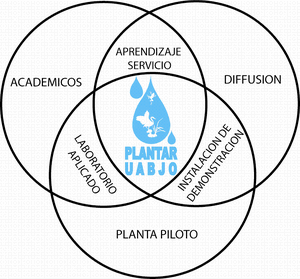
Vision
The project vision entails implementation of a demonstration facility, where UABJO Chemistry Department conducts outreach programs, required water quality analyses, and system operation and maintenance. Outreach programs include an ongoing series of wastewater treatment/reuse and watershed management conferences and hands-on workshops at the demonstration facility. Conferences focus on connecting federal, state and local agencies on health and sanitation with concerned students, faculty and residents within the Oaxaca Valley. Conference topics address community specific water issues such as the context of wastewater treatment in the Oaxaca Valley, funding sources, design processes, treatment technology alternatives, water reclamation, other beneficial uses, challenges to system operation and maintenance, etc.
The demonstration program supports UABJO students, surrounding residents and system visitors to tour the on-campus facility, where participants can gain applied experience with water quality and wastewater collection, treatment, reuse and monitoring practices. In addition, the program incorporates site visits surrounding treatment systems. The international nature of this project may provide opportunities for students and faculty, beyond UABJO and HSU, to become more internationally engaged with the watershed management, health, sanitation and treatment technology represented on-campus.
On-campus wetland wastewater treatment and reuse system
With technical support from HSU, the Chemisty faculty at UABJO spearheaded the construction of a 10,000 cubic meter per day treatment system on-campus. The pilot-scale treatment system is comprised of an upflow anaerobic sludge blanket, a facultative lagoon, two free surface wetlands, a disk filter, storage, and subsurface irrigation for on-campus landscaping. System construction was complete in March 2008, and system start-up is ongoing.
Overall Treatment Goals:
- Reduce total nitrogen by 15%
- Reduce the biochemical oxygen demand and suspended solids to at least 20 mg/l
- Improve habitat for waterfowl
- Reuse wastewater for irrigation
- Prevent the generation of foul odors
Typical Influent Loading Rate and Effluent Goals for Nutrient and Pollutant Rates by EPA Standards
| Constituent | Typical Influent Concentration mg/L | Target Effluent Concentration mg/L |
|---|---|---|
| Hydraulic Load (in/d) | .4-4 | |
| BOD | 5-100 | 5-30 |
| TSS | 5-100 | 5-30 |
| NH3 & NH4 as N | 2-20 | 1-10 |
| NO3 as N | 2-20 | 1-10 |
| TN | 2-20 | 1-10 |
| TP | 1-10 | .5-3 |
Design
1. Upflow anaerobic sludge blanket
Purpose:
- To improve public health conditions by destroying pathogenic organisms
- To reduce the organic content of the wastewater
- To separate the liquids from the solid waste
- Possibility of reusing settled sludge bio solids for use in land application
- Possibility of capturing and using methane from digester for powering plant operations or in direct use for heating or cooking
How it Works:
- the inlet of the waste water comes in at the bottom
- sludge granulation occurs from flow conditions that only allow microorganisms capable of attaching to each other are able to survive and proliferate, these aggregates are known as "granules".
- granules resist washout and thus permit high hydraulic loading into the UASB and thus allowing waste water with low concentration of substrate material.
- granules are also compact with high microbial activity allowing for increased organic loading. One gram of granular sludge (dry weight) can catalyze the conversion of 0.5 g of COD per day into 1g of methane.
- rapid settling occurs from the large particle sizes of granules, with water clarifying faster than the dispersed sludge from a regular anaerobic treatment system. See a [picture of settled sludge] [4]
- methane is produced as well as some CO2 from the break down of organic materials, this methane can be utilized to power the system, produce heat, or used for off system applications like cooking. The design for this system initially wanted to put soil and establish plants above were the methane escapes so that the plants could capture the methane for growth, however these plans were never finished and methane is not currently being used or burned off.
- settled sludge has most pathogens reduced and these solids go to the sludge drying beds
- the waster water outlet flows out the top and has a reduced organic content, reduced Total Suspended Solids (TSS), and reduced pathogens.
-
Before the waste water enters the system
-
-
-
-
The Upflow Anearobic Sludge Blanket Control Station
Sludge Drying Beds
Currently this Waste Water Treatment Facility is not applying the bio-solids as a fertilizer, but we did find that wild tomato plants were thriving in the drying beds. The possibility for utilizing these bio-solids has been demonstrated in other facilities including the Arcata Marsh and waste water treatment facility for the city of Arcata.
Purpose of Sludge Drying Beds:
- Remove settled sludge from UASB
- Possibility of using sludge as fertilizer
- Reducing the amount of water in sludge for increased ease in transport either for land application or for disposal
How it works:
- sludge is manually released from the UASB preferably at times when UASB is not in session so that odors are not problematic,
- the beds are open and relatively long so that sludge can spread out and dry, reducing the weight of the bio-soilds before being transported for re-use or disposal
Advantages of Fertilizer application of Biosolids:
- nitrogen is slowly released in comparison to inorganic fertilizers
- less water soluble and thus less likely to leach into the ground water or surface run off
- improves soil texture and water holding capacity, making it great for root growth and drought tolerance
- after the UASB many pathogens and odors have been reduced rendering this fertilizer much safer
Dis-Advantages of Biosolids Reuse
- though application requires less capital then disposal it requires more labor for oversight
- weather can prevent application thus requiring some way to properly store excess bio-solids
- without effective communication with the public there might be a lot of opposition that has the power to stop the operation
-
The Sludge Drying Beds after construction
-
The Sludge Drying Beds today
-
Tomatos growing in the Sludge Drying Beds
2. Facultative lagoon
Purpose:
- To continue to remove the organic content from the waste water
- To encourage the settling of solids
How it Works:
- Aerobic organisms and facultative organisms live on the surface layer of water, where there is increased amounts of dissolved oxygen due to atmospheric aeration and algal respiration.
- Anearobic organisms live in the bottom layer where sludge settles
- The middle anoxic layer (or layer of depleted oxygen) supports a range from aerobic and anearobic organisms and is termed the facultative zone.
- These layers are not stagnant, but are maintained due to temperature dependent density variations.
- Algae living within the aerobic and falcultative zone are an essential factor for success in the system. When the sun is out, algae use CO2 from the waste water and release O2 from photosynthesis into the surface waters. From the intense use of CO2 by the algae the ph rises above 10 and encourages conditions where dissolved ammonia vaporizes out of the water.
- Oxygen produced by algae is used to stabilize organic material in the upper layer
Advantages:
- removes settilable solids, BOD, pathogens, fecal coliform, and ammonia
- cheaper than other treatment systems commonly used
- easy to operate
- requires little energy if using gravity flow
Dis-Advantages
- requires lots of land
- settled sludge needs to be removed periodically
- mosquitoes and other insects may be problematic without ecosystem support like bird or fish populations or without vegetation control, like cutting back overgrowth where mosquito larvae live
- difficult to control or predict ammonia levels
- can become smelly if aerobic algae are removed from surface
-
The lagoon is an attractive place for recreation as well as providing habitat to animals and treating wastewater from teh school.
-
-
Facultative Lagoon with a healthy green color indicating algal growth.
3. Two surface Wetlands
Purpose:
- Removal of suspended sediments
- Removal of nitrates, nitrites, ammonia, and free nitrogen
- Removal of phosphorous through uptake by wetland plants
- Reduce Biological Oxygen Demand
How it Works:
- plant canopy of reeds and bulrush in water used to prevent growth and persistence of algae and reduces wind turbulence in water.
- submerged portions of the live plants, dead plants, and litter accumulation act as the physical substrate for the microorganisms breaking down nutrients and pollutants
- the low velocity and smooth, mostly undisturbed, laminar flow allows for effective sedimentation of suspended solids.
- sedimentation allows for the removal of some metals and other pollutants
- oxidation of organic materials as well as oxidation of fixed forms of nitrogen (TN) and phosphorous (TP) can release soluble forms of BOD, TN, and TP that are then available to be absorbed by the soil or taken up by the wetland microbes and plants.
- oxygen available at the water surface as well as on wetland roots and rhizomes allows for some aerobic activity that can remove ammonia nitrogen from the waste water [6]
Advantages:
- cheaper maintenance and operation costs
- low energy needs
- low labor requirements
- provides habitat for different animals including acting as a bird migratory pathway
- provides "green space" for recreational activities and can contribute to a park system
- works well at removing suspended sediments, nitrogen, phosphorous, and reducing BOD
DisAdvantages
- requires large amounts of land especially for nitrogen and phosphorous removal
- phosphorous, metals, and some organics build up in the sediment over time and must be periodically removed
- the lack of available oxygen can reduce the nitrification and removal of ammonium
- mosquito problems may persist if there is not a completed ecosystem including mosquito predators like frogs, fish, birds, and other insects.
-
Starting the system with tap water rather then straight waste water
-
WEtland with established and thriving plants today, 2010
-
Thriving ecosystem with dragon flies, fish, and current studies being done on adding shrimp and catfish to help control the mosquito population
-
mixture of cattail and other wetland species
-
Todays wetland with varied species and functioning treatment of waste waters
-
Wetlands are great at reducing the BOD, but leaf litter as well as the decompostion of organisms generated in the wetland contribute to increased organic loading.
-
The wetlands and lagoon were constructed close to a ball court, now a tubes have major clogging issues from balls that enter the open system.
-
Pile of balls collected from clogged inlets and outlet tubes
4. Storage
Purpose:
- Hold on to treated cleaned water for when its use is needed or wanted
5. Subsurface Irrigation
Purpose:
- Reutilize treated and cleaned water to ensure best use
- Demonstrate reuse methods of wastewater
Construction
-
The Construction Begins
-
The Mid-Construction Treatment Plant
-
The Post-Construction Treatment Plant
Outreach program
-
The March 2006 Workshop
-
2006 Workshop Concept 1
-
2006 Workshop Concept 2
-
2006 Workshop Concept 3
Workshops:
- HSU and UABJO collaborated to conduct three wastewater treatment design and watershed management conferences at the UABJO campus in March 2006, Februrary 2008, and August 2009.
There is also an upcoming workshop in March 2011 at UABJO.
Presentations:
- Polluting sources, municipal wastewater discharge conditions by CONAGUA in spanish
- Recycled Water Use by Tressie Word in spanish
- The new politics of water through a structural reform to achieve sustainable development of water sector by Rodolfo Lacy in spanish
- Health treatment system and automated irrigation by Universidad Tecnologica de Coahuila, Salitllo in spanish
- Oaxaca Water Quality Forum August, 2010. The forum was first started by the Institue of Nature and Society in Oaxaca and now the forum is a collaborative effort by many different nonprofits and people passionate about water quality issues in Oaxaca. Presenters at the forum discuss test results of pathogens in water samples, alternative methods for treating waste water and drinking water, as well as the ecological impacts of land use and alternative methods of agriculture and forestry that can protect the watershed.
-
February 2008 Workshop Site Visit
-
Workshop at UABJO Demonstration Facility,
-
Workshop at UABJO Demonstration Facility,
Communities:
- Communities that have treatment systems allready and are having either analysis done by UABJO or recieving outreach from UABJO for an improved system.
- Tlacolula
- Etla
- Zautla
- San Sebastián Tutla
- Ocotlán de Morelos
- Matatlan
- Mitla
- Santa Ana del Valle
- Teotitlan del Valle
- Tlacochahuaya
- Faltantes
- Update from Community Site Visits 2010:
- Zautla: System not functioning. Future workshop and collaboration planned between UABJO and Zautla community to revise plans. Currently the waste water is not reused, but flows back into the river next to the community.
- Etla: System not functioning. Quickly filled with sediment 3 months after placing in system, since rapid population growth out sized the system. Cleaning out sediment has not occurred for financial reasons. Half of the system is has been drained and shut off from more waste water. Waste water now inundates the land around the facility and flows around it. Future collaboration is planned between Water for Humans, an engineering company from the US, as well as a local engineering company to help build capacity here for fixing, maintaining, and installing these waste water treatment plants. Currently Water for Humans does not have much land to be able to extend the system and the land they do have includes a landfill that is not lined and has leaching issues. Thus alternative treatment systems requiring less land, the remediation of the current landfill, or the purchase of more land are three possibilities for getting the treatment system functioning.
-
Zautla Waste water Treatment Plant with Marsh and Lagoon System
-
Water lily plants now cover the surface of the Lagoon, while the wetland system has very little vegetation of cattails left
-
Site Visit 2010 to Zaultla with representatives from UABJO and Zautla community along with engineer Tressie B. Word.
-
Zautla waste water at treatment system
-
Etla Waste Water Treatment plant with a series of connected small chambers to simulate marsh and lagoon systems.
-
Waste water flowing into and around closed off waste water treatment plant, now the area around the system is flooded with waste water.
-
Now half of the treatment system is closed off, dry, full of sediment and growing grass.
-
Site visit 2010 and project team checking and planing for repairing system with representatives from Water for Humans and UABJO along with engineer Tressie B. Word.
| Community | System Functioning | Description |
| Tlacolula | ||
| Etla | N | Sedimentation and rapid population growth out sized system |
| Zautla | N | Sedimentation |
| San Sebastián Tutla | ||
| Ocotlán de Morelos | ||
| Matatlan | ||
| Mitla | ||
| Santa Ana del Valle | ||
| Teotitlan del Valle | ||
| Tlacochahuaya | ||
| Faltantes |
Research and Academic Education
- UABJO has been conducting watershed management/wastewater technology education and surrounding community wastewater system monitoring/analysis since 2006. Masters student and professor research includes Erik Martinex Torres`s thesis on the waste water treatment plant in Tlacolula. Now Torres is a professor in the Chemistry Department at UABJO and his thesis is available in spanish online.
- Currently UABJO, Tressie Word, and Peter Hass are working on a book to document the Treatment System at UABJO and the community outreach¨throughout Oaxaca. The book will have detailed information on the design, construction, experiences, workshops, and communities involved in the project. The book should be coming out in March of 2011 in spanish, then seven months after its published in spanish another version will be coming out in english.
Next steps
- A UAJBO graduate seminar on engineered natural treatment systems operation and maintenance, featuring the on-campus demonstration treatment system, will be held the week of August 30th, 2010.
- Another wastewater treatment and watershed management conference is anticipated for March 2011, with the support of the UABJO, Secretary of Health of Oaxaca (SSO), the Institute of Nature and Society of Oaxaca (INSO) and the Mexico National Water Commission (CONAGUA).
References
- ↑ Haase,Peter H. ABSTRACT FIELD ASSESSMENT OF WASTEWATER TREATMENT FACILITIES IN THE OAXACA VALLEY, MEXICO. http://humboldt-dspace.calstate.edu/xmlui/bitstream/handle/2148/625/Field%20Assessment%20of%20Wastewater%20Treatment%20Facilities%20in%20the%20Oaxaca%20Valley,%20Mexico.pdf?sequence=1
- ↑ Torres,Q.B. Erik Martinez. PANTANOS CONSTRUIDOS, UNA ALTERNATIVA DE SOLUCIÓN PARA MEJORAR LOS SISTEMAS DE TRATAMIENTO DE AGUAS RESIDUALES EN LAS COMUNIDADES DEL ESTADO DE OAXACA, 2010.Thesis para PROGRAMA DE MAESTRÍA EN CIENCIAS QUÍMICO BIOLÓGICAS con la UNIVERSIDAD AUTÓNOMA “BENITO JUÁREZ” DE OAXACA.
- ↑ EPA, Waste Water Technology Fact Sheet, September, 2000. http://water.epa.gov/scitech/wastetech/upload/2002_06_28_mtb_free_water_surface_wetlands.pdf
- ↑ Jim Field, jimfield@email.arizona.edu, September 20th, 2002, http://www.uasb.org/discover/granules.htm
- ↑ United States Environmental Protection Agency, Waste water Technology Fact Sheet, http://water.epa.gov/scitech/wastetech/upload/2002_10_15_mtb_faclagon.pdf
- ↑ EPA, Wastewater Technogy Fact Sheet, Free Water Surface Wetlands. http://water.epa.gov/scitech/wastetech/upload/2002_06_28_mtb_free_water_surface_wetlands.pdf
- ↑ Aquatic plant systems and wetlands have natural treatment functions that can be mimiced and utilized as a much cheaper way to treat human waste water.






